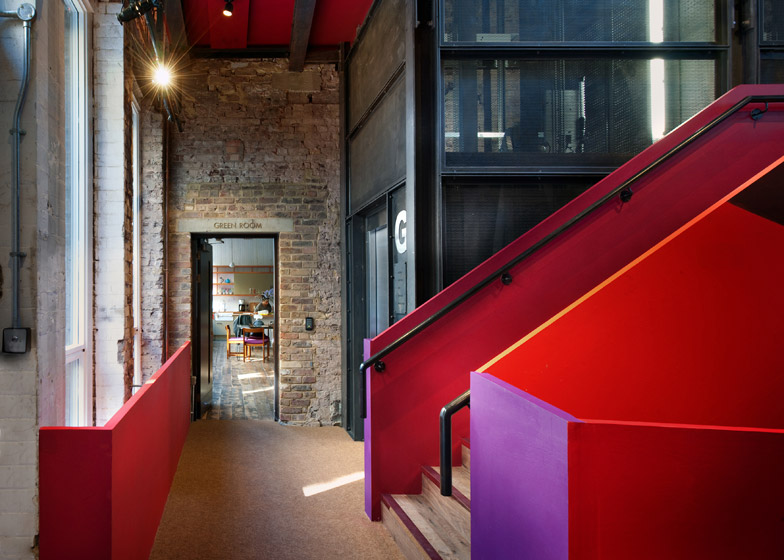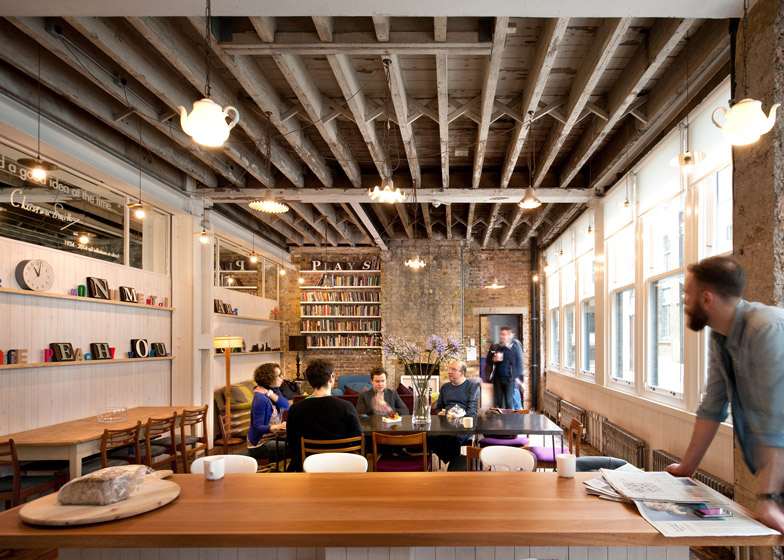Stirling Prize-winner Haworth Tompkins has revamped a former warehouse to create rehearsal and office spaces for one of London's most important theatre companies (+ slideshow).
Haworth Tompkins – which was awarded the UK's most important architecture prize for its redesign of the Liverpool Everyman theatre – was approached by the Donmar Warehouse to create a new facility for rehearsals, education and admin.
The not-for-profit contemporary theatre company had acquired a former warehouse on Dryden Street, close to its original theatre in Covent Garden. Piecemeal development over the years had left behind a complicated structure, but the architects were given free rein to remove walls and floors where necessary.
"The challenge was to design a convivial and creative professional working environment within the constraints of a limited budget and a tightly enclosed site," said the firm.
The renovation hinges around a brightly coloured staircase that jerks up through the centre of the four-storey-high building, and also down into a sizeable basement.
Described by Haworth Tompkins as "the warm heart of the building", the wooden staircase has been hand painted in vivid shades of red, blue and purple by artist Antoni Malinowski – who previously collaborated with the firm on the Everyman, as well as for the renovation of the Chichester Festival Theatre.
The rest of the interior was kept as raw as possible. The old brickwork and its various infills are left exposed throughout, while visible ceiling beams present their original now-peeling paintwork.
"The personality of the historic architecture has been allowed to set the tone, with a provisional, loose-fit language of new additions setting up a fluid, adaptable relationship of new and old," said the firm.
"Materials added have been simple and straightforward – whitewashed plywood, painted timber beams and wall coverings, waxed mild steel – to complement the richly patinated texture of the found surfaces. The aim is very much for a benign occupation rather than an obliteration of the original fabric," it added.
The largest intervention was the addition of a double-height rehearsal space in the basement, of a similar size to the main stage at the Donmar. This was achieved by carving a void through the ground floor.
The resulting space benefits from natural light, as a set of ground floor windows now functions as clerestory glazing.
Most of the remaining ground floor was refurbished to create a green room facing out onto the street, as well as a practice room for musicians.
The first floor became offices, while an education studio was created beneath the roof rafters on the second floor. The architects also found room to slot in an apartment for visiting artists in the attic.
For furnishings, Haworth Tompkins worked with scenographer Lucy Osborne to create an interior intended to be reminiscent of a stage set.
Photography is by Philip Vile, apart from where otherwise indicated.
Project credits:
Architect: Haworth Tompkins
Client: Donmar Warehouse
Contractor: 8Build
Structural engineer: Price & Myers
Services engineer: Skelly & Couch
Acoustic consultants: Gillieron Scott Acoustic Design
Quantity surveyor: Gardiner & Theobald and Jackson Coles
Theatre consultant: Charcoalblue
CDM coordinator: PFB Construction Management
Planning consultants: DP9
Artist: Antoni Malinowski
Scenographer: Lucy Osborne







